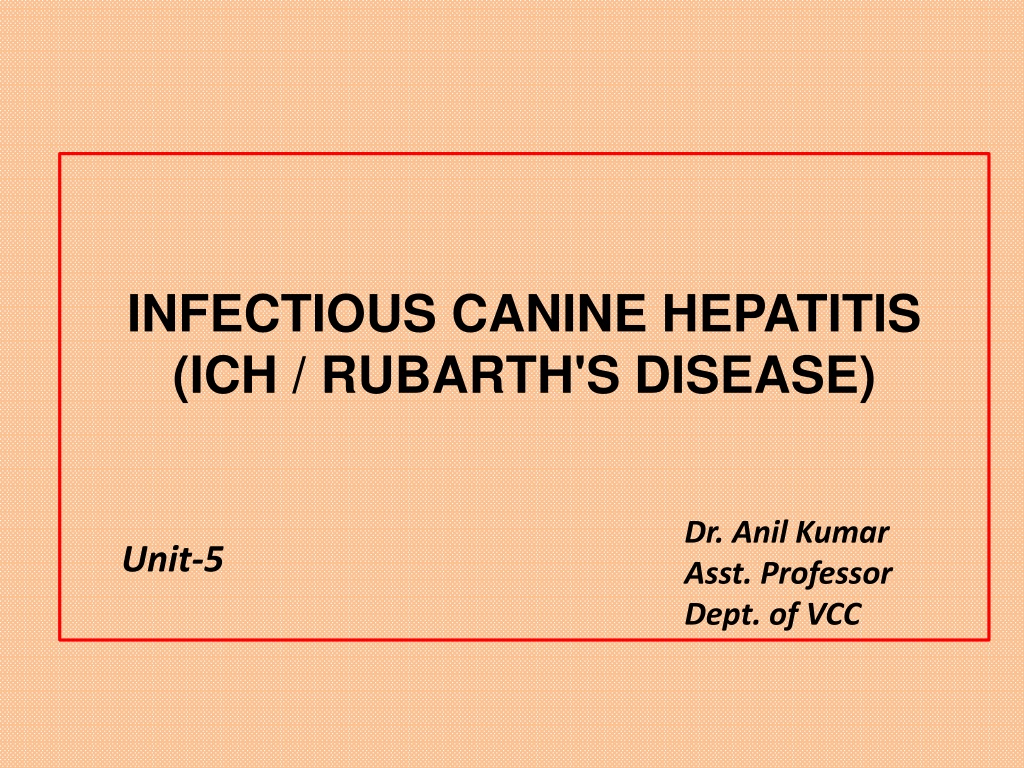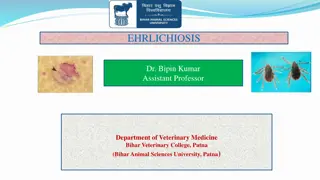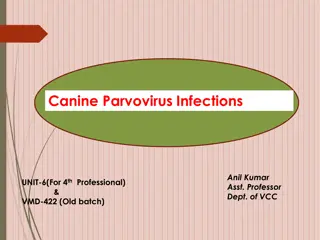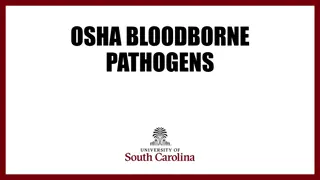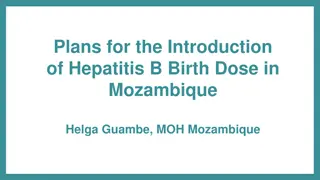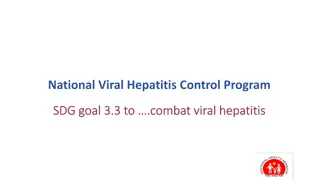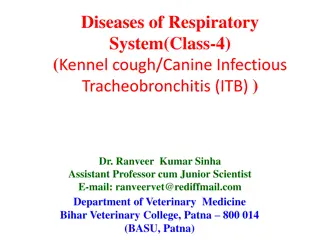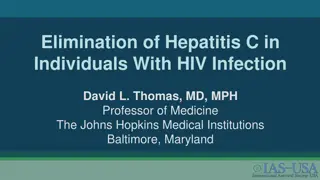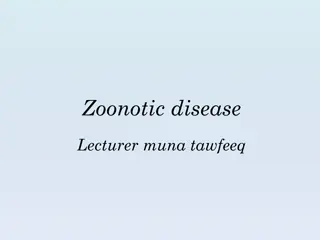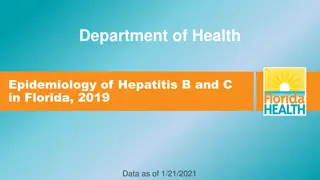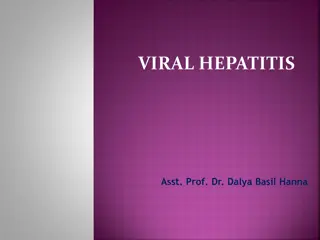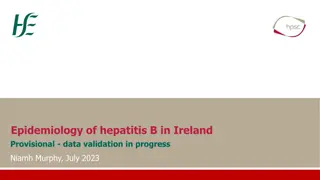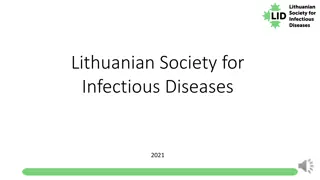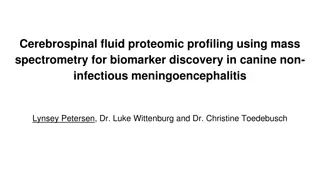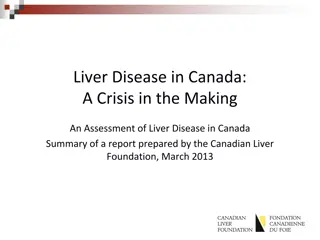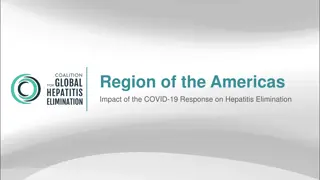Canine Infectious Hepatitis (ICH) - Overview, Symptoms, and Treatment
Canine Infectious Hepatitis (ICH), also known as Rubarth's Disease, is caused by Canine Adenovirus-1 (CAdV-1), affecting dogs of all ages. The virus primarily targets hepatocytes, leading to acute hepatitis, as well as respiratory and ocular issues. Transmission occurs through contact with infected dog urine, with symptoms varying from peracute death to subacute mild fever and gastrointestinal issues. Diagnosis involves considering vaccination history and clinical signs, while treatment focuses on supportive care for acute cases.
Download Presentation

Please find below an Image/Link to download the presentation.
The content on the website is provided AS IS for your information and personal use only. It may not be sold, licensed, or shared on other websites without obtaining consent from the author. Download presentation by click this link. If you encounter any issues during the download, it is possible that the publisher has removed the file from their server.
E N D
Presentation Transcript
INFECTIOUS CANINE HEPATITIS (ICH / RUBARTH'S DISEASE) Dr. Anil Kumar Asst. Professor Dept. of VCC Unit-5
canine adenovirus 1(CAdV-1), a DNA Virus Systemic disease Any age but, young dogs, in the first 2 years of life, are more likely to die than older one ETIOLOGY: Dogs and other candis including foxes, wolves, coyotes, skunks, and bears The virus has a predilection for hepatocytes, vascular endothelium, and mesothelium In dogs, causing acute hepatitis, respiratory or ocular disease. HOST RANGE Most often via the oral route by contact with urine from infected dogs. Recovered animal shed virus up to 6 months in their urine TRANSMISSION
PATHOGENESIS VIRUS ENTERS THROUGH ORAL ROUTE VIREMIA (4-8Days) & MULTIPLICATION AT TONSILS AND SPREAD TO LOCAL LYMPH NODES GOES TO THE SYSTEMIC CIRCULATION & DISSEMINATED TO OTHER TISSUES AND BODY SECRETIONS Cytotoxic effect of Virus ENDOTHELIAL CELLS OF MANY TISSUES BONEMARROW &LYMPHOID TISSUES HEPATIC/RENAL/OCCULAR PARENCHYMA SEROSALHAEMORRHAGE HEPATITIS/ Ag &Ab complex GLOMERULONEPHRITIS/UVEITIS LEUKOPENIA, ANAEMIA AND FEVER
CLINICAL FINDINGS PERACUTE FORM: Death within few hour after onset of clinical signs Survived viraemic period have abdominal and with or without haemorrhage. High temperature, enlarged and colouration buccal mucosa. Subacute form: Common >1 year of age Mild rise of body temperature (103-104 F) Mild photophobia Enlarged tonsils Recovered easily but weight regaining is very slow. ACUTE FORM: Starts with apathy, anorexia and High body temperature, followed by vomition or diarrhoea Faeces often blood tinged with abdominal pain. Saddlecurve like fever. Increased pulse and respiration Tonsilitis, pharyngitis, laryngitis, coughing and respiratory pneumonia. Dog shows haemorrhagic buccal mucosa and abdominal tenderness Tucked up abdomen with pain on palpation at liver region Defective clotting mechanism Blue Eye disease , a transit corneal opacity haemorrhage and ulceration of eyes the animals vomition, pain diarrhoea hoarse sounds lower and intense thirst, tonsils red of due to
Diagnosis: It may be suspected in any dog less than 1 year of age that has a questionable vaccination history and signs of fever, respiratory, gastrointestinal, and hepatic disease, and certainly in any young dog that develops corneal edema.
Treatment and Control: Dogs with acute ICH require supportive care and consists primarily of fluid therapy, including crystalloid fluids and blood products. Antiemetics, antacids, sucralfate, whole blood or plasma transfusions, and colloids such as hetastarch. Partial or total parenteral nutrition for those that do not tolerate enteral feeding. Management of hepatic encephalopathy with lactulose enemas, oral lactulose (in the absence of vomiting), and poorly absorbed oral antimicrobial drugs such as ampicillin may also be indicated. The use of parenteral broad-spectrum antimicrobial drugs should be considered for dogs with hemorrhagic gastroenteritis that may develop bacteremia as a result of bacterial translocation. For severe corneal edema and uveitis, use topical ophthalmic preparations that contain glucocorticoids and atropine to prevent development of glaucoma.
Prevention: Immunization: Vaccines should be administered every 3 to 4 weeks from 6 weeks of age, with the last .vaccine given no earlier than 16 weeks of age. Proper disinfection, isolation, and prevention of overcrowding and other co-infections, which may worsen disease. There is no evidence that CAV-1 infects humans. Young adult dog with corneal edema
